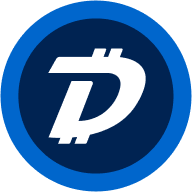DigiByte价格
(美元)$0.007155
-- (--)
USD
市值
$1.29亿 #141
流通总量
179.46亿 / 210亿
历史最高价
$0.18407
24 小时成交量
$398.38万
3.6 / 5


了解DigiByte
DigiByte(DGB)是一个专为速度、安全性和可扩展性设计的去中心化区块链。作为一个社区驱动的项目,它采用五种不同的挖矿算法来增强安全性和去中心化特性。DigiByte具备15秒的交易确认时间和低廉的手续费,优化了日常支付和数字交易场景。其210亿枚DGB的固定发行总量确保了稀缺性,类似比特币模型但更具普及性。核心创新是DigiDollar——一种去中心化稳定币,用户可将DGB作为抵押品锚定美元代币,在保持价格稳定的同时继承了DigiByte快速、免信任的基础设施优势。这使DGB兼具交易资产和去中心化金融(DeFi)储备货币的双重属性。
本内容由 AI 生成
免责声明
本页面的社交内容 (包括由 LunarCrush 提供支持的推文和社交统计数据) 均来自第三方,并按“原样”提供,仅供参考。本文内容不代表对任何数字货币或投资的认可或推荐,也未获得欧易授权或撰写,也不代表我们的观点。我们不保证所显示的用户生成内容的准确性或可靠性。本文不应被解释为财务或投资建议。在做出投资决策之前,评估您的投资经验、财务状况、投资目标和风险承受能力并咨询独立财务顾问至关重要。过去的表现并不代表未来的结果。您的投资价值可能会波动,您可能无法收回您投资的金额。您对自己的投资选择自行承担全部责任,我们对因使用本信息而造成的任何损失或损害不承担任何责任。提供外部网站链接是为了用户方便,并不意味着对其内容的认可或控制。
请参阅我们的 使用条款 和 风险警告,了解更多详情。通过使用第三方网站(“第三方网站”),您同意对第三方网站的任何使用均受第三方网站条款的约束和管辖。除非书面明确说明,否则欧易及其关联方(“OKX”)与第三方网站的所有者或运营商没有任何关联。您同意欧易对您使用第三方网站而产生的任何损失、损害和任何其他后果不承担任何责任。请注意,使用第三方网站可能会导致您的资产损失或贬值。本产品可能无法在所有司法管辖区提供或适用。
请参阅我们的 使用条款 和 风险警告,了解更多详情。通过使用第三方网站(“第三方网站”),您同意对第三方网站的任何使用均受第三方网站条款的约束和管辖。除非书面明确说明,否则欧易及其关联方(“OKX”)与第三方网站的所有者或运营商没有任何关联。您同意欧易对您使用第三方网站而产生的任何损失、损害和任何其他后果不承担任何责任。请注意,使用第三方网站可能会导致您的资产损失或贬值。本产品可能无法在所有司法管辖区提供或适用。
DigiByte 的价格表现
近 1 年
+6.14%
$0.01
3 个月
-20.31%
$0.01
30 天
-11.78%
$0.01
7 天
-10.73%
$0.01
DigiByte 社交媒体动态

参议员们和我非常高兴地宣布推出数字黄金 CFV CoinFund 1。
该基金将投资 2 亿美元于有前景的 Layer 1 OG 数字黄金加密商品项目。
此外,我们将拨出 8 亿美元购买这些币,并将其在十年内保留在储备中。
我们坚信这些币代表了加密货币的未来,作为交换媒介或金融系统的基础。这些币代表了数字自由货币。它们使得各方之间能够私密且不受限制地转移硬资产,免受金融机构和政府的干预,正如中本聪白皮书中所设想的那样。
一年后,代表这些 L1 Coin Funds 的代币将在合格投资者之间可交易,可能在像 Tzero 这样的安全和受监管的平台上。
该基金的主要目标是为其投资者创造利润。通过直接与这些核心团队和社区合作并支持其发展,我们朝着实现这一目标迈出了重要一步。


🌐 如果不是通过 **TCP/IP** 的 **直接点对点 (P2P)** 连接,那就 **不是真正的去中心化。** $BTC $DGB
让我们来分析一下 👇
🧠 **TCP/IP** = 传输控制协议 / 网络协议。
它是整个互联网的 *数字基础* — 让计算机能够在全球范围内直接相互通信的通用语言。
📦 **IP** 就像一个地址 — 它告诉每个数据包 *去哪里*。
📬 **TCP** 就像挂号邮件 — 它确保数据安全、完整、有序地到达。
TCP/IP 使 **真正的端到端通信** 成为可能 — 没有服务器,没有中介,不需要许可。 ⚡
🤝 **P2P (点对点)** 意味着你的设备 **直接** 连接到另一个人的设备 — 不是通过公司的云,不是通过登录界面,也不是通过其他人的 API。 只有 **你 ↔ 他们**。
💎 这就是 *真正的区块链* 所做的。
每个节点运行自己的软件,并通过 **TCP/IP** 直接与全球其他节点通信。
它们共享区块,验证交易,并保持网络活跃 — *没有守门人,没有中央控制。*
🚫 但是如果你必须“登录”、“注册”或“访问一个网站”才能使用它……你并不是在使用去中心化的区块链。
你是在使用一个 **集中式应用**,它坐落在 *互联网之上*,假装是去中心化的。
🔥 真实的去中心化 =
**你 ↔ 网络**
**节点 ↔ 节点**
**TCP/IP ↔ TCP/IP**
零中介。零许可。100%自由。
这就是互联网本该是的样子。
这就是区块链诞生的目的。 💪💙
#Decentralization #Blockchain #P2P #DigiByte

快捷导航
DigiByte购买指南
开始入门数字货币可能会让人觉得不知所措,但学习如何购买比您想象的要简单。
预测 DigiByte 的价格走势
DigiByte 未来几年值多少?看看社区热议,参与讨论一波预测。
查看 DigiByte 的价格历史
追踪 DigiByte 代币的价格历史,实时关注持仓表现。您可以通过下方列表快捷查看开盘价、收盘价、最高价、最低价及交易量。

DigiByte 常见问题
目前,一个 DigiByte 价值是 $0.007155。如果您想要了解 DigiByte 价格走势与行情洞察,那么这里就是您的最佳选择。在欧易探索最新的 DigiByte 图表,进行专业交易。
数字货币,例如 DigiByte 是在称为区块链的公共分类账上运行的数字资产。了解有关欧易上提供的数字货币和代币及其不同属性的更多信息,其中包括实时价格和实时图表。
由于 2008 年金融危机,人们对去中心化金融的兴趣激增。比特币作为去中心化网络上的安全数字资产提供了一种新颖的解决方案。从那时起,许多其他代币 (例如 DigiByte) 也诞生了。
查看 DigiByte 价格预测页面,预测未来价格,帮助您设定价格目标。
深度了解DigiByte
DigiByte 旨在成为一种更快的数字货币,使用可用于数字资产、智能合约、去中心化应用程序和安全身份验证的创新区块链。
ESG 披露
ESG (环境、社会和治理) 法规针对数字资产,旨在应对其环境影响 (如高能耗挖矿)、提升透明度,并确保合规的治理实践。使数字代币行业与更广泛的可持续发展和社会目标保持一致。这些法规鼓励遵循相关标准,以降低风险并提高数字资产的可信度。
资产详情
名称
OKCoin Europe Ltd
相关法人机构识别编码
54930069NLWEIGLHXU42
代币名称
DigiByte
共识机制
DigiByte is present on the following networks: Digibyte, Tron.
DigiByte employs a multi-algorithm Proof of Work (PoW) consensus model with five separate hashing algorithms, offering greater security and decentralization than single-algorithm blockchains. These five algorithms are SHA-256, Scrypt, Qubit, Skein, and Groestl. Core Components of DigiByte’s Consensus: 1. Multi-Algorithm Design: a. The use of five distinct PoW algorithms allows a diverse range of miners with various types of hardware (ASICs, GPUs, FPGAs) to participate in securing the network. b. By spreading mining power across multiple algorithms, DigiByte minimizes the risk of any single mining group controlling the network. This multi-algorithm approach protects against 51% attacks by making it more difficult for a malicious actor to control a majority of the network’s hash power. 2. Real-Time Difficulty Adjustment: a. DigiByte uses Dynamic Difficulty Adjustment for each algorithm individually. This means that the difficulty level for each algorithm can adjust in real-time based on network conditions and hashing power. b. The system prevents any single algorithm from producing blocks faster than others, ensuring even distribution of block production across all algorithms and preventing sudden spikes in mining difficulty. 3. Segregated Chain for Security: a. DigiByte implements a unique multi-layered blockchain structure that segments the blockchain to allow faster validation and improved security. b. The use of separate algorithms in a layered approach reduces the chance of a blockchain split or double-spend attacks and increases the blockchain’s scalability.
The Tron blockchain operates on a Delegated Proof of Stake (DPoS) consensus mechanism, designed to improve scalability, transaction speed, and energy efficiency. Here's a breakdown of how it works: 1. Delegated Proof of Stake (DPoS): Tron uses DPoS, where token holders vote for a group of delegates known as Super Representatives (SRs)who are responsible for validating transactions and producing new blocks on the network. Token holders can vote for SRs based on their stake in the Tron network, and the top 27 SRs (or more, depending on the protocol version) are selected to participate in the block production process. SRs take turns producing blocks, which are added to the blockchain. This is done on a rotational basis to ensure decentralization and prevent control by a small group of validators. 2. Block Production: The Super Representatives generate new blocks and confirm transactions. The Tron blockchain achieves block finality quickly, with block production occurring every 3 seconds, making it highly efficient and capable of processing thousands of transactions per second. 3. Voting and Governance: Tron’s DPoS system also allows token holders to vote on important network decisions, such as protocol upgrades and changes to the system’s parameters. Voting power is proportional to the amount of TRX (Tron’s native token) that a user holds and chooses to stake. This provides a governance system where the community can actively participate in decision-making. 4. Super Representatives: The Super Representatives play a crucial role in maintaining the security and stability of the Tron blockchain. They are responsible for validating transactions, proposing new blocks, and ensuring the overall functionality of the network. Super Representatives are incentivized with block rewards (newly minted TRX tokens) and transaction feesfor their work.
奖励机制与相应费用
DigiByte is present on the following networks: Digibyte, Tron.
DigiByte incentivizes network participation and security through block rewards, transaction fees, and a deflationary schedule for block rewards. Incentive Mechanisms: 1. Block Rewards for Miners: a. Miners receive newly minted DGB tokens for successfully mining blocks. This block reward encourages miners to contribute computing power to secure the network and validate transactions. b. DigiByte’s block rewards follow a deflationary schedule, decreasing over time, which promotes long-term value by controlling the rate of token issuance. 2. Transaction Fees: a. Users pay transaction fees in DGB tokens for network activities. These fees are distributed to miners, providing them with an ongoing income source and incentivizing efficient transaction processing. 3. Real-Time Difficulty Adjustment: a. Difficulty adjustments are calculated based on the hashing power of each algorithm, ensuring fair distribution of rewards and reducing the risk of a single mining pool or participant dominating the network’s hashing power. Applicable Fees: Transaction fees on DigiByte are calculated based on network demand, with miners prioritizing transactions with higher fees during congested periods. The larger block size reduces overall fees, supporting affordability for users.
The Tron blockchain uses a Delegated Proof of Stake (DPoS) consensus mechanism to secure its network and incentivize participation. Here's how the incentive mechanism and applicable fees work: Incentive Mechanism: 1. Super Representatives (SRs) Rewards: Block Rewards: Super Representatives (SRs), who are elected by TRX holders, are rewarded for producing blocks. Each block they produce comes with a block reward in the form of TRX tokens. Transaction Fees: In addition to block rewards, SRs receive transaction fees for validating transactions and including them in blocks. This ensures they are incentivized to process transactions efficiently. 2. Voting and Delegation: TRX Staking: TRX holders can stake their tokens and vote for Super Representatives (SRs). When TRX holders vote, they delegate their voting power to SRs, which allows SRs to earn rewards in the form of newly minted TRX tokens. Delegator Rewards: Token holders who delegate their votes to an SR can also receive a share of the rewards. This means delegators share in the block rewards and transaction fees that the SR earns. Incentivizing Participation: The more tokens a user stakes, the more voting power they have, which encourages participation in governance and network security. 3. Incentive for SRs: SRs are also incentivized to maintain the health and performance of the network. Their reputation and continued election depend on their ability to produce blocks consistently and efficiently process transactions. Applicable Fees: 1. Transaction Fees: Fee Calculation: Users must pay transaction fees to have their transactions processed. The transaction fee varies based on the complexity of the transaction and the network's current demand. This is paid in TRX tokens. Transaction Fee Distribution: Transaction fees are distributed to Super Representatives (SRs), giving them an ongoing income to maintain and support the network. 2. Storage Fees: Tron charges storage fees for data storage on the blockchain. This includes storing smart contracts, tokens, and other data on the network. Users are required to pay these fees in TRX tokens to store data. 3. Energy and Bandwidth: Energy: Tron uses a resource model that allows users to access network resources like bandwidth and energy through staking. Users who stake their TRX tokens receive "energy," which is required to execute transactions and interact with smart contracts. Bandwidth: Each user is allocated a certain amount of bandwidth based on their TRX holdings. If users exceed their allotted bandwidth, they can pay for additional bandwidth in TRX tokens.
信息披露时间段的开始日期
2024-10-14
信息披露时间段的结束日期
2025-10-14
能源报告
能源消耗
246193686.72158 (kWh/a)
可再生能源消耗
29.306425039 (%)
能源强度
4.39588 (kWh)
主要能源来源与评估体系
To determine the proportion of renewable energy usage, the locations of the nodes are to be determined using public information sites, open-source crawlers and crawlers developed in-house. If no information is available on the geographic distribution of the nodes, reference networks are used which are comparable in terms of their incentivization structure and consensus mechanism. This geo-information is merged with public information from Our World in Data, see citation. The intensity is calculated as the marginal energy cost wrt. one more transaction.
Ember (2025); Energy Institute - Statistical Review of World Energy (2024) - with major processing by Our World in Data. “Share of electricity generated by renewables - Ember and Energy Institute” [dataset]. Ember, “Yearly Electricity Data Europe”; Ember, “Yearly Electricity Data”; Energy Institute, “Statistical Review of World Energy” [original data]. Retrieved from https://ourworldindata.org/grapher/share-electricity-renewables.
能源消耗来源与评估体系
The energy consumption of this asset is aggregated across multiple components:
For the calculation of energy consumptions, the so called 'top-down' approach is being used, within which an economic calculation of the miners is assumed. Miners are persons or devices that actively participate in the proof-of-work consensus mechanism. The miners are considered to be the central factor for the energy consumption of the network. Hardware is pre-selected based on the consensus mechanism's hash algorithm: multiple. A current profitability threshold is determined on the basis of the revenue and cost structure for mining operations. Only Hardware above the profitability threshold is considered for the network. The energy consumption of the network can be determined by taking into account the distribution for the hardware, the efficiency levels for operating the hardware and on-chain information regarding the miners' revenue opportunities. If significant use of merge mining is known, this is taken into account. When calculating the energy consumption, we used - if available - the Functionally Fungible Group Digital Token Identifier (FFG DTI) to determine all implementations of the asset of question in scope and we update the mappings regulary, based on data of the Digital Token Identifier Foundation. The information regarding the hardware used and the number of participants in the network is based on assumptions that are verified with best effort using empirical data. In general, participants are assumed to be largely economically rational. As a precautionary principle, we make assumptions on the conservative side when in doubt, i.e. making higher estimates for the adverse impacts.
To determine the energy consumption of a token, the energy consumption of the network(s) tron is calculated first. For the energy consumption of the token, a fraction of the energy consumption of the network is attributed to the token, which is determined based on the activity of the crypto-asset within the network. When calculating the energy consumption, the Functionally Fungible Group Digital Token Identifier (FFG DTI) is used - if available - to determine all implementations of the asset in scope. The mappings are updated regularly, based on data of the Digital Token Identifier Foundation. The information regarding the hardware used and the number of participants in the network is based on assumptions that are verified with best effort using empirical data. In general, participants are assumed to be largely economically rational. As a precautionary principle, we make assumptions on the conservative side when in doubt, i.e. making higher estimates for the adverse impacts.
排放报告
DLT 温室气体排放范围一:可控排放
0.00000 (tCO2e/a)
DLT 温室气体排放范围二:外购排放
101430.82924 (tCO2e/a)
温室气体排放强度
1.81108 (kgCO2e)
主要温室气体来源与评估体系
To determine the GHG Emissions, the locations of the nodes are to be determined using public information sites, open-source crawlers and crawlers developed in-house. If no information is available on the geographic distribution of the nodes, reference networks are used which are comparable in terms of their incentivization structure and consensus mechanism. This geo-information is merged with public information from Our World in Data, see citation. The intensity is calculated as the marginal emission wrt. one more transaction.
Ember (2025); Energy Institute - Statistical Review of World Energy (2024) - with major processing by Our World in Data. “Carbon intensity of electricity generation - Ember and Energy Institute” [dataset]. Ember, “Yearly Electricity Data Europe”; Ember, “Yearly Electricity Data”; Energy Institute, “Statistical Review of World Energy” [original data]. Retrieved from https://ourworldindata.org/grapher/carbon-intensity-electricity Licenced under CC BY 4.0.
市值
$1.29亿 #141
流通总量
179.46亿 / 210亿
历史最高价
$0.18407
24 小时成交量
$398.38万
3.6 / 5





